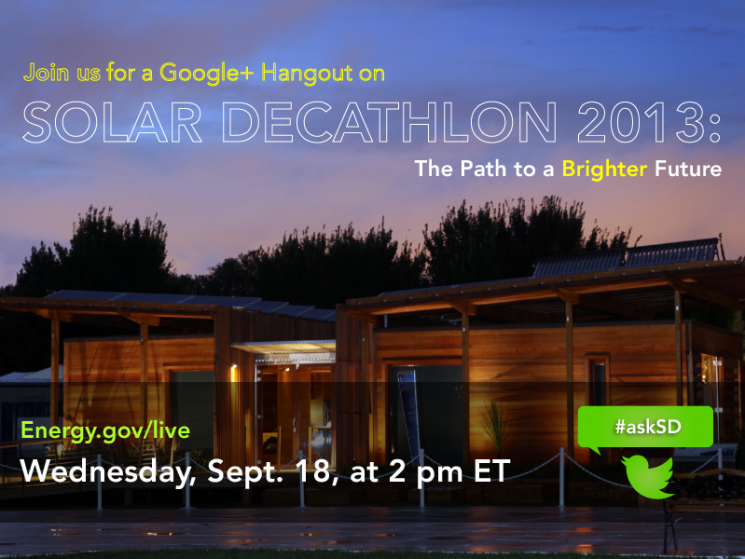Hangout With Solar Decathlon 2013 Teams on Sept. 18!
Wednesday, September 11, 2013By Rebecca Matulka
Editor’s Note: This entry has been cross-posted from DOE’s Energy Blog.

Mark your calendars for a Google+ Hangout on Solar Decathlon 2013: The Path to a Brighter Future on Wednesday, Sept. 18, at 2 p.m. ET.
For more than 10 years, the U.S. Department of Energy Solar Decathlon has been preparing the next wave of energy leaders—providing hands-on experience in designing and building energy-efficient, solar-powered houses. As teams put the finishing touches on their entries for this year’s event—which is less than three weeks away—a few teams are taking time to answer your questions about what it takes to be a solar decathlete and how the competition will impact their careers.
Join us Wednesday, Sept. 18, at 2 p.m. ET for a Google+ Hangout on Solar Decathlon 2013: The Path to a Brighter Future. The live discussion will be streamed on Google+, YouTube, and energy.gov/live.
Whether you want to know how the teams turn their innovative building ideas into reality or ask about some of the latest energy-saving technologies incorporated into the houses, now is your chance to ask. We will be taking your Solar Decathlon questions in advance and during the Hangout. You can submit them by emailing newmedia@hq.doe.gov, posting comments on the Energy Department’s Facebook page or Google+ event, or tweeting @ENERGY using #askSD.
Solar Decathlon Director Richard King will moderate the discussion and be joined by team members from:
- Arizona State University and The University of New Mexico
Arizona State University and The University of New Mexico have designed and built SHADE—a house that pays tribute to desert plant life while maximizing occupant comfort and flexibility. With an independent solar canopy, modular furniture, and phase-change material used to redistribute energy in the house, SHADE will grow and adapt with its owners. - Santa Clara University
Santa Clara University’s Radiant House is an elegant, adaptable, and affordable house with a versatile great room, a large deck and patio area, and clean separation between private and public spaces. The house’s innovative features include a structural wall and joist system made of standard lumber and bamboo, a radiant heating and cooling system embedded in the ceiling, and a custom application that controls and monitors the entire house. - Team Alberta: University of Calgary
To address housing shortages and high costs for northern Alberta’s energy, mining, and forestry professionals, the team from the University of Calgary created Borealis. Designed to be sustainable and ecologically sensitive, Borealis includes two modules that flank a shared service core that includes kitchen, dining room, bathroom, and a mechanical room. The house also features a living wall that naturally detoxifies the air and is sustained by large sun-tunnel skylights. - Team Capitol DC: The Catholic University of America, George Washington University, and American University
With HARVEST HOME, students from the Catholic University of America, George Washington University, and American University have created a house that replenishes as much energy as it uses. After the competition, HARVEST HOME will be donated to a veteran in need—a purpose that is reflected in the house’s calming design and integration with the outdoors. - University of Nevada Las Vegas
The University of Nevada Las Vegas designed its DesertSol house to reflect the spirit of the Mojave Desert and make careful use of the area’s solar and water resources. The house includes a weathered wood rain screen that provides shade to the outdoor space, retractable solar shade screens to shield the house from summer heat and provide direct sun for warmth in the winter, and super-efficient insulation that ensures the house is airtight and highly heat-resistant.
We look forward to answering your Solar Decathlon questions!
Rebecca Matulka is a digital communications specialist in the Department of Energy’s Office of Public Affairs.
Tags: Solar Decathlon, Solar Decathlon 2013, Teams
